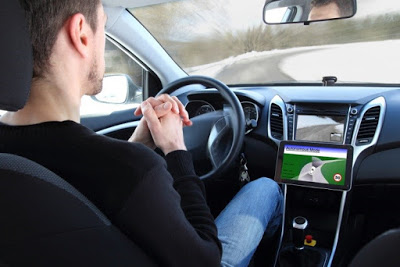 Now that more than one company is in on the self-driving car game — Google was the primary mover and shaker, but now Mercedes-Benz, Nissan, Audi, and a half-dozen other automotive firms are testing their own driverless vehicles — we can be fairly certain that autonomous cars will be hitting roads sooner rather than later.
Now that more than one company is in on the self-driving car game — Google was the primary mover and shaker, but now Mercedes-Benz, Nissan, Audi, and a half-dozen other automotive firms are testing their own driverless vehicles — we can be fairly certain that autonomous cars will be hitting roads sooner rather than later.
While dozens of car experts giggle and squeal over the impending innovation, the rest of us bite our nails over how the new technology will impact the real world. For fun (or for fear) here are a handful of ways self-driving vehicles could change the look and feel of our roads.
Better: Accident Rate
According to one study by the National Highway Traffic Safety Association, Americans cumulatively experience more than 32,999 fatalities, 3.9 million injuries and 24 million damaged vehicles every year. The main causes for collisions such as these are driver behaviors, namely speeding, driving while intoxicated, and driving distracted. The integration of autonomous cars eliminate all three of these issues, which means that so many lives would be spared every year — not to mention the annual $871 billion spent on collisions that would go back into the economy.
Worse: Car Design and Car Culture
Cars tend to look like they do for the sake of the driver: large windshields, windows and mirrors, dashboard gauges, and storage are configured to make driving easier and safer. Of course, through the years, cars have changed shape due to drivers’ whims as well. Gear heads prefer smart organization, sleek bodies, and sonorous engines, and car designers have responded with sports cars like Dodge’s Challenger and Charger models.
Unfortunately, driverless car designers are less than encouraged to follow established (and attractive) car design. For example, Google’s self-driving car is utterly cartoonish: a bubble with a face and wheels. Most car experts predict a sharp decline in car culture, as passengers have less interaction with cars, they will have less interest in how they look and feel to drive. Thus, we might soon all be driving around bulbous monstrosities instead of sinuous machines.
Better: Auto Theft
Modern computers have a number of security features designed to ensure only their proper owners have access to their private digital information, and when computers take over cars’ functions, they will likely inherit all the excellent protection technology to prevent car theft. Of course, this may increase the rates of carjacking, putting car owners at risk for the sake of their vehicle passwords, but with essential GPS, driverless cars can be easily recovered by police.
Worse: Driving Age
Driving is the penultimate adult responsibility: Teens who drive are just a step away from becoming fully autonomous adults. However, when cars themselves are autonomous, a person of any age can safely get behind the wheel. This presents all sorts of challenges: For one, irresponsible children can go far and wide without any adult supervision; for another, the driver’s license is the current de facto identification card, and the demise of licenses requires a federal reworking of the identification system.
Additionally, a lack of driving age may eliminate the need for a national drinking age. In 1987, the primary reason the federal government upheld the drinking age was to mitigate traffic-related injuries and deaths among the youth. When no sober driver is necessary, the arguments against individual liberty and individual responsibility nearly completely dissolve.
Better: Telecommuting
Thanks to the Internet, many modern workers can do their jobs from almost anywhere, and when self-driving cars hit the market, many will surely take advantage of commuting time to do more work. In fact, an autonomous car could easily be transformed into a mobile office, replete with telephone, computer, and other devices necessary for productivity. On the one hand, this is a definite boon for frequent business travelers, who can better utilize drive time; on the other hand, this means there is even less time when it is appropriate for modern workers to clock out and relax.
Better: Auto Insurance
Drivers have insurance to protect their vehicles and themselves against damage from collisions, but when the chance of a collision is almost zero, few car owners will be willing to give away thousands of dollars each year for nothing. By declining to pay auto insurance, Americans can save $220 billion every year. However, most auto insurance firms will not be able to withstand such a significant financial hit and will have to close their doors, while others will have to refocus, suing manufacturers instead of passengers.
Worse: Driver Career Outlook
Perhaps the most disastrous result of integrating autonomous cars on the roads is the substantial loss of transportation and shipping jobs. Millions of American workers make their living from driving: truckers, bus drivers, limo drivers, taxi drivers, delivery drivers, movers, and more. Unfortunately, many thousands of these workers are injured or die due to collisions every year, but more unfortunately, the introduction of driverless cars will put all of these millions of drivers out of work for good, which will swell the already-full ranks of our nation’s unemployed.
The innovation associated with self-driving cars is incredibly exciting — but the ramifications could be ruinous. Perhaps we should stop and think before we rush to the dealership to buy our shiny, new, autonomous bubble cars.

